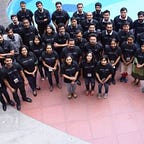#mywaterstory- Uma Mani
“I grew up in a large family of 11 cousins including my little brother. Even as a child, I was curious and mischievous. I was the so-called “Leader” of our happy cousin’s gang. When I was a kid, I had no idea what scuba diving was, but I knew I wanted to learn to swim. Even though I learned it much later in life, I am grateful that I did.
I started painting at the age of 45 and I was looking for a theme to hold a painting expo. It was then that I watched a documentary on coral reefs and grew fascinated with them. Slowly, I began to understand more about them, and I was residing in the Maldives at the time with my husband, who is a medical practitioner, so corals were all around me.
I was nervous before diving for the first time, but curiosity and excitement gradually overtook my feelings. I saw a lot of fish the first time I went underwater, and it was a pretty surreal experience. Since I did my PADI certification in the Maldives, the visibility underwater was clear and it was much more beautiful and surreal than I had expected. Soon after, I learned about the plight of corals all around the world, and I was filled with worry and concern.
I do scuba diving at least twice or thrice a year. My day to day is almost the same as any other individual, I cook for my family, handle the household chores, read about coral reefs, and paint every day. In addition, I engage in online webinars and speak at institutions about the oceans and coral reefs.
One of my dreams was to make a documentary about “coral reefs,” and I even shot an underwater movie with my GoPro, but I didn’t know how to produce a documentary, which requires a thorough understanding of aspects of filmmaking. Then I began contacting many documentary filmmakers; luckily, Ms. Priya Thuvassery believed in me and stepped in. She, on the other hand, wanted to produce a documentary on my journey, so it became “Coral woman” rather than “Coral reef gardens,” as I had initially intended.
Today, I dedicate 25%-50% of the proceeds from my paintings to coral restoration. I speak to students and employees of organizations on proper garbage disposal, solar energy, and rainwater conservation. Of course, I use all of these techniques at home. If we as citizens can just accomplish the three things listed above, we will be able to save both the land as well as the oceans.
We require the oceans at this time since they are also an important part of our ecosystem. Above all, we must ensure that every living entity has the opportunity to live in peace and that their surroundings do not become dump yards. To safeguard both our land and our oceans, sewage should be treated before being released into the oceans, trash on the beach should be prohibited, garbage should be responsibly disposed of, and renewable energy sources such as solar power, rainwater collection, and tree planting should be encouraged.”
Check out our other articles: Water Revolution- Projects & Initiatives in India, Increasing Water Footprint- A concern for all!
For more blogs- www.indrawater.com
